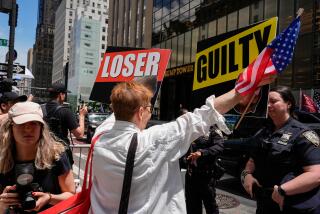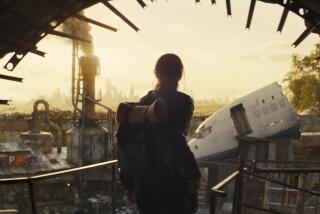Department of offense
JAMES CARROLL was born on the same day as the Pentagon in 1943 and he deems it his destiny to destroy that monstrous citadel. He cavorted there as a boy while his father served the ministries of war as they amassed atomic bombs and prepared to drop them on much of humanity. He aspired in college to join the family business in uniform, defending America against communists and his dad’s Air Force against the Navy’s budget designs. Overcome in the ‘60s by fear of a nuclear conflagration and by the horrors of Vietnam, he marched around the familiar five-sided factory with Norman Mailer’s antiwar armies of the night and let the Berrigan brothers tempt him into the leftist Catholic clergy. Although he soon quit the priesthood, he never gave up preaching, hoping with books and newspaper columns to find peace with his alienated father and peace in the world. These quixotic missions are now woven into a massive memoir of the Atomic Age that lets Carroll hurl thermonuclear bolts against his hated “House of War” on the Potomac, no longer just a building but a metaphor for the evil empire that he thinks his beloved country has become.
Such a sermon needs an Original Sin and Carroll found it in his numerological fascination with the year of his birth. It was in 1943 also that President Franklin D. Roosevelt met in Casablanca with Britain’s Prime Minister Winston Churchill and insisted on demanding the “unconditional surrender” of Nazi Germany. By thus refusing to bargain with Hitler or his less rabid associates, Carroll contends in “House of War,” the Allies committed themselves to a war of “vengeance” instead of a negotiable purpose, a decision that culminated in the aerial massacre of hundreds of thousands of civilians.
Inexorably, those raids led to the firebombing of Tokyo and other Japanese cities, whose horrendous casualties left no moral barrier, once the A-bomb was readied, to the incineration of Hiroshima and Nagasaki. In Carroll’s furious rendering of the competing histories of those years, he leaves no room for military imperatives, good intentions or the stubborn venality of enemy regimes. The sin of using nuclear weapons, he is certain, was further corrupted by the desire to intimidate the Soviet Union, and from that moment on it was American perfidy and only Soviet reaction that propelled humanity to decades of unnecessary competition on the edge of the thermonuclear abyss:
“A truth of the Cold War,” he writes, “would be that one engine could drive both escalations, Soviet and American, and the engine room was, more often than not, in the bowels of the building on the Potomac River.”
Citing President Eisenhower’s afterthought, on leaving office, about the danger posed by a military-industrial complex, Carroll expands the indictment to include American universities, labor unions and other contract-hungry political elites, all of whom joined in “a frenzied cycle in which money feeds on fear which feeds on power which feeds on violence which feeds on a skewed idea of honor which feeds on demonization of an enemy which feeds on more fear which feeds on ever more money.”
And at the Pentagon, where Gen. Joseph Carroll was then helping the Air Force outgun the Navy in annual budget battles, his son now discerns the bureaucratic equivalent of a nuclear reactor run amok. A-bombs begat H-bombs and bombers begat missiles and missiles begat multiple warheads, and they all inspired risks and attitudes and military doctrines that resulted in the bloodbath of Vietnam -- James Carroll’s first mature experience of war. In the ghastly and superfluous cruelties of that conflict, he is overcome with hatred of all war and proceeds to project that abhorrence back to World War II and forward to Iraq.
The result is a massively ambitious history by a man notably lacking a sense of history. He writes as if his father’s generation (Tom Brokaw’s “greatest”) invented total warfare, with no reference to the mythologies of ancient Troy and Egypt and only passing mention of the slaughter of America’s native Indians, Sherman’s march through Georgia, the Japanese rape of Nanking, the German terror bombings of Guernica, Warsaw, Rotterdam and London and the Nazis’ systematic murder of Jews.
In a most revealing epilogue, looking from his father’s grave in Arlington National Cemetery across to the memorials on Washington’s mall, Carroll describes the Holocaust museum as resembling a death factory and says it produces “nothing so much as reminders that, perhaps, some wars are necessary.” Reflect a moment on that “perhaps.” Carroll’s failure to distinguish between just and unjust wars even to himself is this book’s fatal flaw.
Though rich in compassion, full of personal guilt and social pain, the book has other flaws. Among the most serious is Carroll’s insensitivity to the American experience of World Wars I and II: how bitterly and totally our people were summoned from insular safety to rush to the rescue of a world gone mad. He gives the back of the hand to the efforts of the war’s victors to build institutions -- and weapons, to be sure -- that would avoid a third call for sacrifice.
Also missing is any real sense of the fears that Stalin’s terror regimes in Russia and in captive Eastern Europe aroused in the West, fears that inevitably evoked the ghost of Hitler and became greatly amplified when nuclear weapons rendered Americans vulnerable in their homes as never before.
It is undeniable that our fears long outlasted Stalin, perhaps even too long, and that our actions exacerbated Russian fears and responses. Both societies, even after they set out to control the arms race, struggled through a new age of anxiety to master the strategies and tactics of nuclear offenses, defenses and deterrence. As Carroll most angrily demonstrates, they relied for much of the Cold War on “mutual assured destruction,” holding their civilian populations hostage to a potential second strike so as to deter a first attack. It was (“perhaps,” as he would say) an immoral approach. But it kept the nuclear peace.
Carroll’s skills as a novelist produce some deft portraits of important Cold War figures, especially his designated villains, Lt. Gen. Leslie R. Groves and Gen. Curtis E. LeMay and Defense Secretary James Forrestal, who sponsored the most extreme reactions to postwar crises. But Carroll also vilifies diplomat George F. Kennan for his influential and hostile perceptions of Stalin and his success in urging the “containment” of the Soviet Union. Carroll thinks, simplistically, that the Pentagon’s greedy war machine got the better of all U.S. diplomats and presidents. In his warped mirror, only “the people” marching for a freeze on nuclear weapons finally forced President Reagan to respond to Soviet leader Mikhail Gorbachev’s overtures to end the Cold War. And of course the war machine quickly found new missions for itself in Iraq I and II.
Carroll’s readings of history are interwoven tightly with memories of his father, who is already enshrined in his “An American Requiem,” which won a National Book Award in 1996. Clearly, the torment persists: When called upon in 1969 to support an intelligence claim that the Soviet Union was developing a first-strike force, “[m]y father dissented, as I understand it, and he was fired. It was the time when I defied him on Vietnam. It may have been the rank narcissism of an Oedipally wounded man to think so, but I had nevertheless imagined all those years that I, as much as [Defense Secretary Melvin R.] Laird, had broken my father.”
The younger Carroll’s turmoil continues: “[T]he lies of the Pentagon were his true infirmity. I inherited it. We took our malady out on each other. If he and I had found a way at last to sit together without resentment, it was only because he no longer knew who I was” -- because Gen. Carroll died of Alzheimer’s in 1991, “coterminous with the launching of America’s next war and the next set of lies. How can I explain that this was no mere coincidence for me, but entry into a new kind of time? The arrow of time found its target in my heart. It is here, in this moment, that my total preoccupation with war and peace -- what drives this book -- shows itself for what it is: not political, as for most others, but completely personal.”
Not until the last page of this confused chronicle, in rage now against the current Pentagon, does the venom drain a bit from Carroll’s view of the past. Looking around from his father’s grave, he is reminded of other, unnamed leaders who found a way not to dread war with Moscow, to create treaties and honor them, to nurture diplomacy, to turn back the fiercest tempers among them and to allow for liberal doubt.
“I see what there is to honor as well as to regret,” he concludes. “My father and his cohort were neither religious nor political fundamentalists. Their successors may be both. Beware the House of War when understood as the House of God.” *
More to Read
Sign up for Essential California
The most important California stories and recommendations in your inbox every morning.
You may occasionally receive promotional content from the Los Angeles Times.










